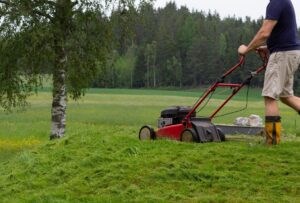With over 15 years of expertise in turf grass science, I’ve had the privilege of witnessing the transformative effects of Verticut Lawn across the globe. This technique is a game-changer, and through this comprehensive guide, you’ll grasp why so many individuals are opting for verticut lawn care to achieve greener, healthier yards.
Understanding the Power of Verticut Lawn Care
Why trim your lawn, you ask? Well, that brings us to the concept of vertical cropping, also referred to as verticuttering or verti-cutting. In essence, this method involves delicately cutting into the thatch layer of your lawn—a blend of grass clippings, roots, and organic matter that can accumulate on the soil’s surface. While some thatch is beneficial, excessive buildup can hinder the flow of water, nutrients, and air to the soil.
Advantages of Verticuttering Your Lawn:
Enhanced Soil Vitality: By removing the thatch layer, the soil gains enhanced breathability, promoting efficient water absorption and robust root growth.
Aesthetic Enhancement: A lawn treated with verticuttering boasts a cleaner, healthier appearance, as it encourages the growth of fresh grass.
Disease Resilience: Reduced thatch minimizes the risk of diseases, bolstering the overall strength of your lawn.
Optimal Timing and Frequency for Verticuttering
Determining the right time to perform verticuttering depends on your specific grass type. Warm-season grasses like Bermuda and Zoysia benefit most when verticut in the transition from late spring to early summer. On the other hand, cool-season varieties such as Kentucky bluegrass or fescue thrive when verticut in early fall.
Frequency Guidelines:
While a minor intervention is often sufficient, an annual verticut is generally recommended. However, if your thatch exceeds half an inch in thickness, consider conducting this procedure twice a year for optimal results.
Essential Steps for Effective Verticut Lawn Care

Proper Mowing: Before commencing the process, mow your lawn slightly shorter than usual.
Pre-Process Hydration: Lightly water your lawn the day before verticuttering.
Executing Verticuttering: Utilize a specialized verticutter machine, ensuring comprehensive coverage of each section.
Debris Cleanup: Upon completion, gather and properly dispose of the removed thatch.
Hydration and Nourishment: Provide adequate water and consider using a mild fertilizer to support post-verticut growth.
Nurturing Your Verticut Lawn
Expect some initial roughness in your lawn’s appearance after verticuttering; this is temporary. Through proper care, your lawn will soon flourish into the lush, green expanse you envision.
Watering Strategy: Maintain slightly moist soil to facilitate grassroots revival and strengthening.
Mowing Timing: Wait until your grass has grown 50% taller than its intended cutting height before mowing.
Fertilization: Apply a suitable fertilizer to expedite the healing process, ensuring not to over-fertilize and stress the grass.
Scientific Insights on Verticutting
Numerous studies highlight the virtues of vertical farming. Notably, research published in the International Turfgrass Society Research Journal indicates that regular verticuttering can increase soil water content by up to 60%, benefiting grass roots and overall lawn health.
A Glimpse into the Future of Lawn Care
Verticut lawn care goes beyond trends—it’s a method supported by decades of turfgrass expertise and scientific backing. The results are evident: a dense, resilient, and vibrant lawn.
Embrace the Potential of Verticuttering
For those seeking the best for their yard, embracing the potential of verticuttering is a wise choice. Through this method, you’ll witness a remarkable transformation right before your eyes.
Distinguishing Verticuttering from Dethatching
While dethatching gently removes dead grass and organic matter from the lawn’s surface, verticuttering involves making deeper, narrower cuts into the soil to promote optimal grass growth.
Frequency of Verticutting
Normally, verticutting is recommended once a year. However, lawns with excess thatch may require biannual verticutting sessions.
Unveiling the Effects of Verticuttering
Also known as “verti mowing,” this practice contributes to robust grass growth by penetrating the surface layer and stimulating new growth.
Setting Verticutter Height
The appropriate height setting varies based on grass type and desired outcomes, typically adjusted to cut just beneath or into the thatch layer. Always consult the machine’s instructions.
Extent of Verticuttering
In most cases, vertical mowing penetrates just a few millimeters into the soil, sufficient to cut through the thatch and reach the underlying soil.
Depth of Verticuttering
Verticuttering depth ranges from 1/8 inch to 1/2 inch (3mm to 12mm), aiming to penetrate just beneath the thatch layer.
Enhancing Grass through Verticuttering
Vertical mowing, frequently used on golf greens, delivers multiple advantages:
- Improved airflow, water penetration, and nutrient distribution to grassroots.
- Encouragement of new grass growth.
- Minimized disease risk by reducing excess thatch.
- Enhanced smoothness of golf course greens.
Embrace the potential of verticuttering and explore innovative ways to enhance your lawn, such as introducing vibrant hues with ground-covering yellow flowers. For more insights on this captivating approach, check out our guide on covering the ground with yellow flowers

